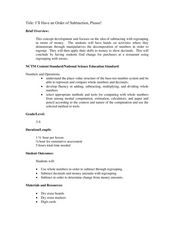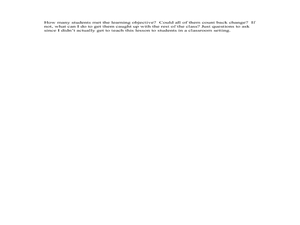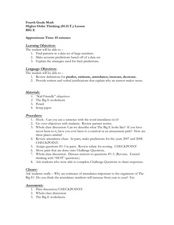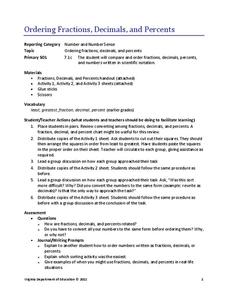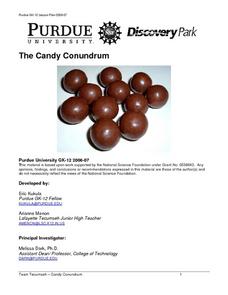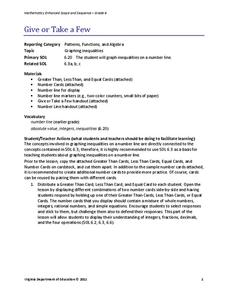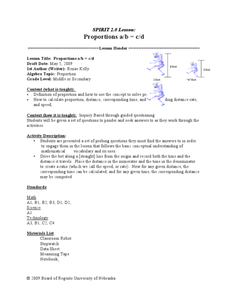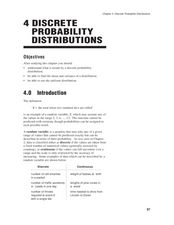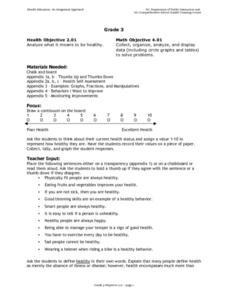Curated OER
I'll Have an Order of Subtraction Please!
Students explore number values by completing consumer math worksheets. In this math functions lesson, students identify the use of a decimal in numbers and the place values that are represented when dealing with money. Students complete...
Curated OER
Do You Value That Digit?
Sixth graders explore the term digit using large number and comma cards as they create numbers. For this digit value lesson, 6th graders identify the value of digits in large numbers and receive additional practice with the new...
Curated OER
Money Game
Fourth graders give change of one dollar. In this decimal and fractions instructional activity, 4th graders receive fake coins and discuss what they could purchase with them. Students go for a walk and spend one dollar...
Curated OER
Higher Order Thinking (H.O.T.) Lesson - BIG E
Fourth graders work with patterns while using large numbers. In this patterning lesson, 4th graders go over the definitions of the words: predict, estimate, attendance, increase, and decrease. They complete worksheets in which they track...
Virginia Department of Education
Ordering Fractions, Decimals, and Percents
Order up a resource on comparing rational numbers. Scholars order fractions, decimals, and percents by converting to a single form. They conduct a cut-and-paste activity ordering three sets of rational numbers.
Curated OER
Coin Carnival
Students investigate the value of coins. In this coin value lesson, students read The Penny Pot by Stuart Murphy. Students expand on skills learned in the book and engage in activities to determine the value of a mixed set of coins while...
Ohio Department of Education
Fraction and Decimal Equivalency
Mathematicians make representations of fractional parts of a whole and learn that a decimal is another way to represent a fractional part. Understanding is extended by comparing and ordering fractions and decimals on a number line. This...
Curated OER
Million Dollar Project
Students calculate how they will spend a million dollars. In this millionaire math activity, students complete a worksheet and then make a poster of how they would spend a million dollars. Each item and its cost must be...
Curated OER
Bar Graphs
Third graders examine the main parts of a bar graph and how to round up to the nearest tenth. They make an example of a bar graph and answer questions based on the graph using a list of state capitals and their average temperatures....
Curated OER
Circles-Diameter, Circumference, Radius and the Discovery of Pi
Seventh graders measure the diameter, circumference and radius of a circle and find pi using the diameter and circumference. In this geometry lesson, 7th graders work in groups to find the diameter, radius, and circumference of circles....
Curated OER
The Candy Conundrum
Students design a candy container that contains a specific amount of candy. They demonstrate how an engineering problem can be solved with math and that there are multiple answers to the problem. They compute volume of spheres.
Curated OER
Shopping Around
Third graders select a recipe and compare prices for ingredients at two different stores. They select the best place to buy the ingredients and answer questions about the process. They include their data on a spreadsheet related to their...
National Security Agency
Borrowing from Our Neighbors
Young mathematicians explore two-digit subtraction. They will investigate multiple ways to subtract numbers involving regrouping. Resources are provided.
Curated OER
Percents: What's the Use?
Young scholars explore percentages in real world situations. In this percents lesson, students determine the final sales price after discounts. Young scholars interview community members and determine how percentages are used in the real...
Virginia Department of Education
Give or Take a Few
Young mathematicians extend their knowledge of rational numbers on a number line to graph inequalities by first using number cards to compare rational numbers. They finish by using similar reasoning to graph inequalities on a number line.
Curated OER
Proportions a/b=c/d
Young scholars calculate distance and proportion of objects. For this algebra lesson, students define proportion and how it is used in math. They solve the problem through guided instruction.
Curated OER
All Kinds of Numbers
Count and compare numbers and fractions using "greater than" and "less than." Learners count on by 2s and 10s and represent the end number with base ten blocks, counters, and cups. They use circle stickers to illustrate fractions and...
Curated OER
Fraction Dominoes
Fourth graders participate in a math game that involves practicing their equivalent fraction skills in the advanced multiplication stage seven. They assess their ability skills of equivalent fractions to match twenty seven dominoes on...
Curated OER
What's in the Bag?
Help your students identify the attributes of two-dimensional shapes. They read the book Round is a Mooncake, and use pattern blocks to sort shapes. Students sort shapes according to their attributes.
Curated OER
Subtraction with Regrouping Lesson Plan
Learners explore regrouping while subtracting. In this subtraction lesson plan, pupils manipulate base 10 blocks to demonstrate regrouping. Multiple resources are provided.
Illustrative Mathematics
Seven to the What?!?
Sometimes what seems like the easiest problem is really the most difficult. Your class is first going to reach for their calculators, but will realize the number is too large to evaluate. Now what? This is where the fun and the...
Curated OER
4 Discrete Probability Distributions
Students read and complete problems on how to solve discrete probability distributions. In this probability distributions lesson plan, students read math problem examples and solve them.
Curated OER
Guess My Rule
Young scholars drill on math patterns, functions and Algebra. They construct and use tables to solve problems associated with mathematical relationships and identify a rule/equation. Students comprehend input/output to determine the...
Curated OER
Analyzing Health
Third graders analyze their health. In this analysis lesson plan, 3rd graders rate their health on a 1-10 scale. They then tally the scores from the class and create a data chart. Then they answer true and false questions based on...
